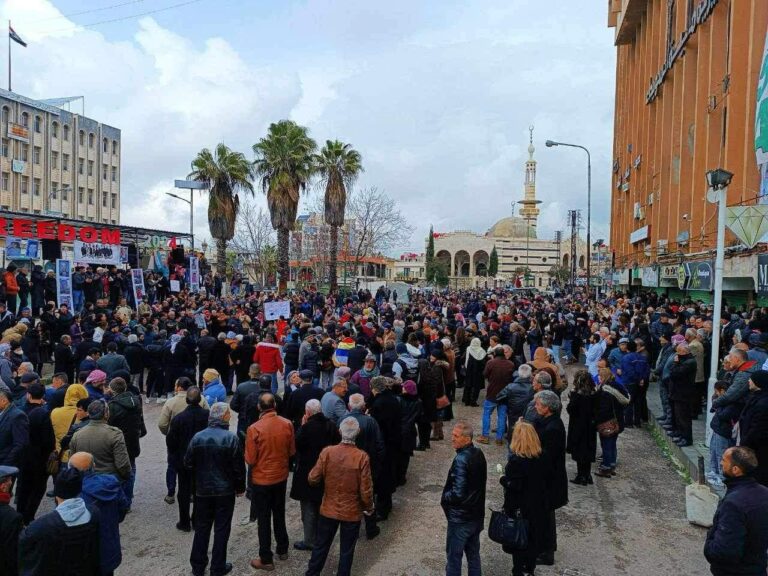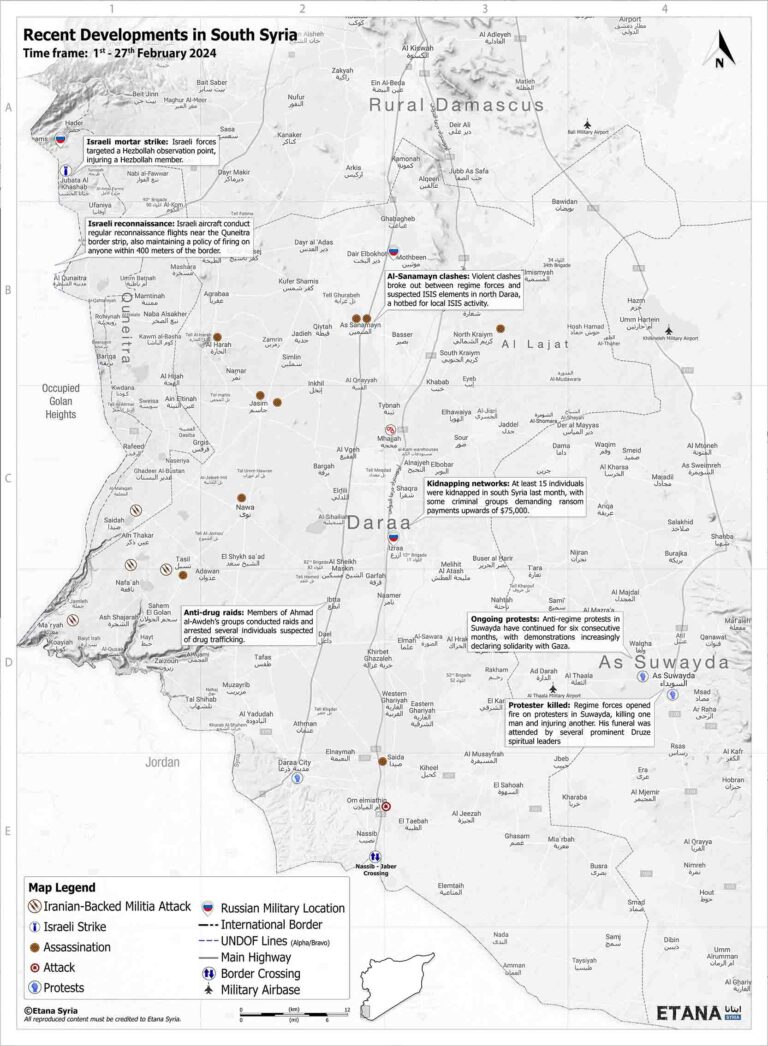Cross-border hostilities between Israeli forces and Iranian-backed militias in south-west Syria have continued to decline in both frequency and intensity. A sharp drop in the number of missile attacks by Liwa al-Quds and Lebanese Hezbollah has been mirrored by a reduction in Israeli counterattacks, with sustained losses to personnel and infrastructure from Israeli strikes likely pushing Iran’s proxy forces to stand down. Russia has also worked to sustain a slightly enlarged but still limited footprint in south Syria, undertaking patrols multiple times per week. Although the Assad regime is unable to significantly impact the overall security situation across the south, it has reduced raids and other activities as Damascus lays the groundwork for parliamentary elections expected to take place later this year. Despite this, in late February, regime forces opened fire on a peaceful protest in Suwayda, killing one man.
Attached Map:
Recent Developments in South Syria
(For a high-resolution version of this map, please use the form at the bottom of the page)
Conflict with Israel
Attacks by Iranian-backed militias targeting the Israeli-occupied Golan Heights have declined in recent weeks, with a concurrent reduction in the number of militants posted to front-line positions in Daraa and Quneitra. Earlier in the month, the Israeli army launched dozens of mortar strikes targeting locations across south Syria, including a Hezbollah observation point where one member was killed. Other mortar strikes hit regime and Iranian-affiliated positions in southern Rural Damascus, Al-Qom, and Al-Rafeed, killing at least four regime soldiers. Israeli aircraft have also continued to conduct reconnaissance flights over the Quneitra border strip on a near daily basis while maintaining a policy of firing on any individual who approaches within 400 meters of the border strip.
Pro-Regime Activity
Russian forces have continued to perform routine patrols every few days across eastern Daraa and northern Quneitra, seeking to bring a sense of security to the region and calm cross-border tensions between Israeli and Iranian-backed forces. The operations have been largely ineffectual.
Operations & Raids
The northern Daraa city of Al-Sanamayn witnessed violent clashes after a raid by regime forces targeted suspected ISIS elements, resulting in the deaths of at least 10 individuals. Divided down the middle between areas of regime military and civilian control, the city is a perennial source of tension and is a hotbed for local ISIS activity.
Given the sustained international pressure on the regime to reduce flows of Captagon and other drugs from south Syria into neighboring states, regime units have continued to stage theatrical raids on drug warehouses in the region, invariably warning smugglers ahead of time who flee the scene hours before security personnel arrive. Recent raids in Daraa province resulted in no arrests. Meanwhile, groups affiliated with Ahmad al-Awdeh and settlement formations carried out raids in eastern and western Daraa, resulting in the arrest of two individuals suspected of drug trafficking.
Instability in South Syria
Endemic levels of societal violence, as well as frequent attacks against regime forces and other local authority figures, continues across south Syria. Amidst an overall security vacuum, myriad clashes between armed groups, local disputes and assassinations against a range of figures have resulted in a tense and precarious security environment. Unchecked criminality and extortion is still being regularly reported from communities across Daraa and Quneitra provinces.
Instances of organized kidnapping and demanding of ransoms have continued to surge, prompting residents to call on local authorities to intervene. Nevertheless, at least 15 individuals were kidnapped across the region in recent weeks, among them civilians and relatives of drug smugglers. Criminal groups demanded ransom payments of more than $75,000 for the return of kidnapped individuals.
Humanitarian Developments
On 28th February, regime forces opened fire on peaceful protesters in Suwayda, killing one 52-year-old man and injuring another. The incident prompted clashes between local factions and regime forces later that day. Local Druze spiritual leader Sheikh Hikmat al-Hijri has urged demonstrators to remain peaceful. Beyond Suwayda, however, the number of public protests across the south has generally declined, with two demonstrations in Daraa in recent weeks attracting around 230 people who protested in solidarity with Gaza and demanded the release of detainees from regime prisons.
Ongoing violence and instability in south Syria continue to push young people to attempt dangerous journeys to Europe. More than 100 young people from Daraa and Quneitra departed from Libya during the month of February.







